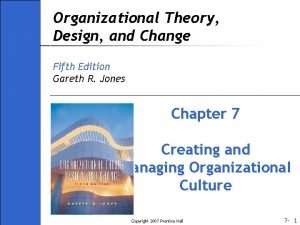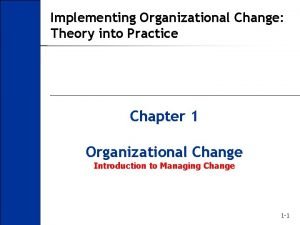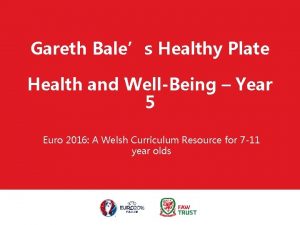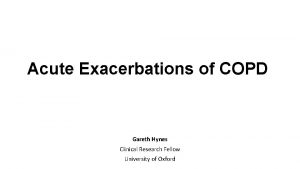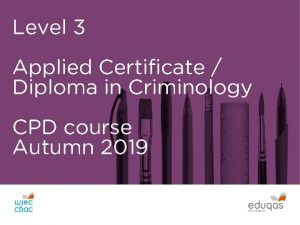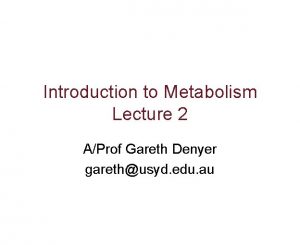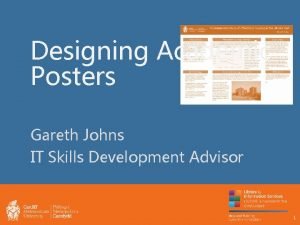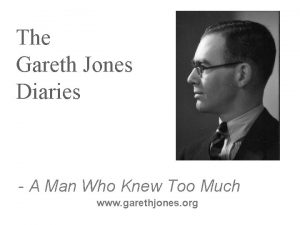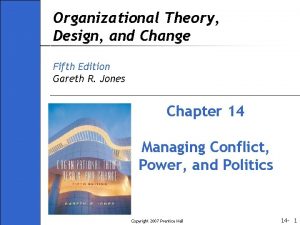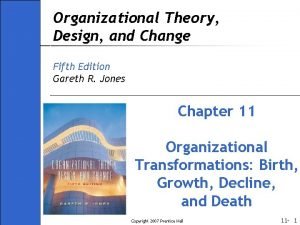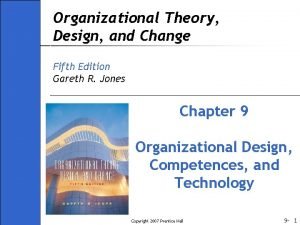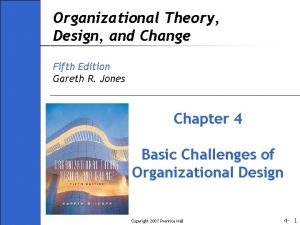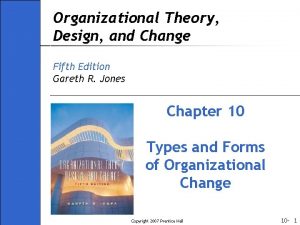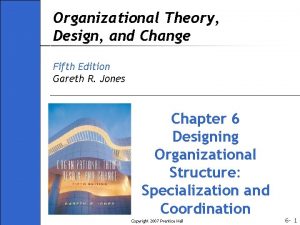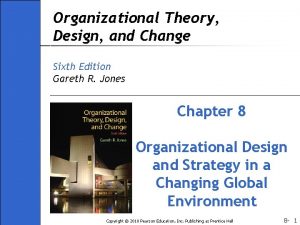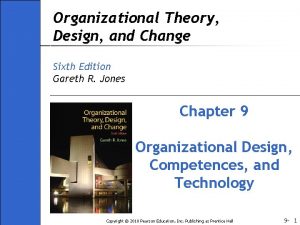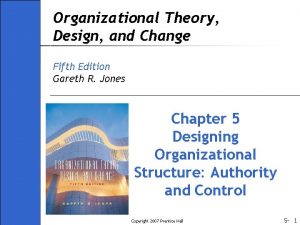Organizational Effectiveness Organizational Theory Design and Change Gareth

















- Slides: 17

Organizational Effectiveness Organizational Theory, Design, and Change Gareth R. Jones Copyright © 2010 Pearson Education, Inc. Publishing as Prentice Hall 1 -1

What is an Organization? n Organization: a tool used by people to coordinate their actions to obtain something they desire or value n Organizations provide goods and services n Organizations employ people n Organizations bring together people and resources to produce products and services n Basically, organizations exist to create value Copyright 2010 Pearson Education, Inc. Publishing as Prentice Hall 1 - 2

How Does an Organization Create Value? n Value creation takes place at three stages: input, conversion, and output n Each stage is affected by the environment in which the organization operates n Environment – the set of forces and conditions that operate beyond an organization’s boundaries but affect its ability to acquire and use resources to create value Copyright 2010 Pearson Education, Inc. Publishing as Prentice Hall 1 - 3

How an Organization Creates Value? Copyright 2010 Pearson Education, Inc. Publishing as Prentice Hall 1 - 4

Why Do Organizations Exist? People working together to produce goods and services create more value than people working alone 5 major reasons why organizations exist: n To increase specialization and the division of labor n n Division of labor allows specialization Specialization allows individuals to become experts at their job n To use large-scale technology n n Economies of scale: cost savings that result when goods and services are produced in large volume Economies of scope: cost savings that result when an organization is able to use underutilized resources more effectively because they can be shared across several different products or tasks Copyright 2010 Pearson Education, Inc. Publishing as Prentice Hall 1 - 5

Why Do Organizations Exist? (cont. ) n To manage the external environment n n n External environment consists of the political, social, economic, and technological factors that affect organizations Organizations regularly exchange products and services for needed resources Organizations need to manage their external environment n To exert power and control n Organizations structure their members to efficiently produce products and services n To economize on transaction costs n Transaction costs: the costs associated with negotiating, monitoring, and governing exchanges between people who must cooperate Copyright 2010 Pearson Education, Inc. Publishing as Prentice Hall 1 - 6

Why Organizations Exist? Copyright 2010 Pearson Education, Inc. Publishing as Prentice Hall 1 - 7

Organizational Theory, Design, and Change: Some Definitions n Organizational theory: the study of how organizations function and how they affect and are affected by the environment in which they operate n Organizational structure: the formal system of task and authority relationships that control how people to coordinate their actions and use resources to achieve organizational goals n Organizational culture: is the set of key values, beliefs, and attitudes shared by organizational members and helps shape the behavior within the organization Copyright 2010 Pearson Education, Inc. Publishing as Prentice Hall 1 - 8

Some Definitions (cont. ) n Organizational design: the process by which managers select and manage aspects of structure and culture so that an organization can control the activities necessary to achieve its goals n Organizational change: the process by which organizations move from their present state to some desired future state to increase their effectiveness Copyright 2010 Pearson Education, Inc. Publishing as Prentice Hall 1 - 9

The Relationship Among Organizational Theory, Structure, Culture, Design, and Change Copyright 2010 Pearson Education, Inc. Publishing as Prentice Hall 1 -10

Importance of Organizational Design and Change Effective design is required for high organizational performance 4 Major Reasons why Organizational Design and Change are Important n Dealing with contingencies n n Contingencies are events that might occur and must be planned for – most come from environment Organizations must be designed to be able to effectively respond to environmental changes n Managing diversity n n Differences in the race, gender, and national origin of organizational members have important implications for organizational culture and effectiveness Learning how to effectively utilize a diverse workforce can result in better decision making and more effective workforce Copyright 2010 Pearson Education, Inc. Publishing as Prentice Hall 1 -11

Importance of Organizational Design and Change (cont. ) n Gaining competitive advantage n n n The ability to outperform other companies because of the capacity to create more value from resources Core competences: skills and abilities in value creation embedded in the organization’s people or structures Strategy: pattern of decisions and actions involving core competences that produces a competitive advantage to outperform competitors n Promoting efficiency, speed, and innovation n n The better organizations function, the more value they create The correct organizational design can lead to faster innovation and quickly get new products to market Copyright 2010 Pearson Education, Inc. Publishing as Prentice Hall 1 -12

Consequences of Poor Organizational Design n Decline of the organization n Lower performance n Talented employees leave to take positions in other organizations n Resources become harder to acquire n Resulting crisis may result in organizational failure Copyright 2010 Pearson Education, Inc. Publishing as Prentice Hall 1 -13

Why is Organizational Effectiveness Important? n What is the point is you are not going to perform well? n Maximizing value creation = organizational effectiveness n There are multiple ways to create value and perform well n 3 primary ways discussed in chapter: n n n Control: external resource approach Innovation: internal system approach Efficiency: technical approach Copyright 2010 Pearson Education, Inc. Publishing as Prentice Hall 1 -14

Approaches to Measuring Effectiveness n External Resource Approach (System Resource Approach) n Internal Process Approach (Internal System Approach and Technical Approach) n Goal Approach (Performance Goal Approach) n Integrative Approach (Constituency Approach, Goal Domain, Contingency Approach) Copyright 2010 Pearson Education, Inc. Publishing as Prentice Hall 1 -15

Approaches to Measuring Effectiveness Copyright 2010 Pearson Education, Inc. Publishing as Prentice Hall 1 -16

Measuring Effectiveness: Organizational Goals Managers also measure effectiveness by creating and measuring performance goals n Official goals: guiding principles that the organization formally states in its annual report and in other public documents n Mission: a mission statement explains why the organization exists and what it should be doing n Operative goals: specific long- and shortterm goals that guide managers and employees as they perform the work of the organization Copyright 2010 Pearson Education, Inc. Publishing as Prentice Hall 1 -17
 Organizational theory design and change
Organizational theory design and change Organizational theory design and change
Organizational theory design and change Implementing organizational change theory into practice
Implementing organizational change theory into practice Gareth redenbach
Gareth redenbach Gareth mead
Gareth mead Healthy plate bristol
Healthy plate bristol Gareth hynes
Gareth hynes Gareth price duke
Gareth price duke Imdecisive
Imdecisive Wjec criminology unit 3 answers
Wjec criminology unit 3 answers Gareth denyer
Gareth denyer Gareth johns
Gareth johns Gareth jones
Gareth jones Foogle transl
Foogle transl Dr gareth james
Dr gareth james The crocodile by gareth lancaster
The crocodile by gareth lancaster Gareth philips
Gareth philips Dr gareth hughes
Dr gareth hughes
